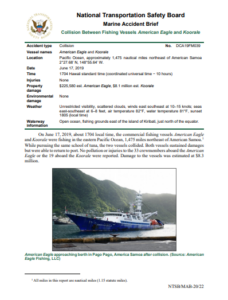NTSB issued an investigation report on the collision of two commercial fishing vessels in the Pacific Ocean, in June 2019, while pursuing the same school of tuna. The report highlighted that neither vessel followed international collision regulations and masters made no attempt to communicate.
The incident
[smlsubform prepend=”GET THE SAFETY4SEA IN YOUR INBOX!” showname=false emailtxt=”” emailholder=”Enter your email address” showsubmit=true submittxt=”Submit” jsthanks=false thankyou=”Thank you for subscribing to our mailing list”]
On June 17, 2019, about 1704 local time, the commercial fishing vessels American Eagle and Koorale were fishing in the eastern Pacific Ocean, 1,475 miles northeast of American Samoa.
While pursuing the same school of tuna, the two vessels collided.
No pollution or injuries to the 33 crewmembers aboard the American Eagle or the 19 aboard the Koorale were reported.
Both vessels sustained damages but were able to return to port. Damage to the vessels was estimated at $8.3 million.
Probable cause
The National Transportation Safety Board determines that the probable cause of the collision between the fishing vessels American Eagle and Koorale was both vessels’ captains and fishmasters not following international collision regulations or communicating to make arrangements while pursuing the same school of fish.
Analysis
The captain and fishmaster on the Koorale both saw the American Eagle up until the collision was imminent.
The captain on the American Eagle, who was navigating the vessel, saw the Koorale the entire time the two vessels were pursing the same school of tuna.
The fishmaster on the American Eagle was also aware of the Koorale’s location and admitted that the two vessels were racing to the same school.
At the time of the accident, it was an hour before sunset, and the sun’s azimuth was 293° at an elevation of 11.75°. The Koorale was west of the American Eagle, and the fishmaster acknowledged that the sun impeded his vision, but only moments before the accident when the two vessels were already on a collision course.
Therefore, both vessels were aware of each other’s location in the moments leading up to the collision. Both vessels’ fishmasters believed their vessels were in position to set their nets and that, according to their “code group” rules, they each had first opportunity to do so.
However, neither vessel had deployed fishing gear or had displayed fishing day shapes.
Regardless of the “code group” rules, the international navigation rules should have guided their interaction. The two vessels were in a crossing situation, and the American Eagle, having the Koorale on its starboard side, should have given way (Rule 15).
The American Eagle did not alter course or speed to avoid the collision, and neither vessel took action until the last moments when the collision could not be avoided.
As the two vessels raced to the same school and toward each other, no attempts were made to communicate. Both fishmasters cited the reason for this was their intense interaction with insults and yelling 2 days prior.
Neither captain stepped in to communicate because of the unofficial hierarchy on board the vessel, where the fishmasters directed the vessel while fishing. Both the American Eagle and Koorale saw each other and knew they were both competing for the same school of tuna.
Had the captains and fishmasters followed the international collision regulations or communicated to make arrangements, a collision could have been avoided.
Explore more herebelow:
































































